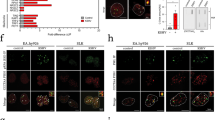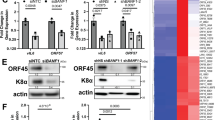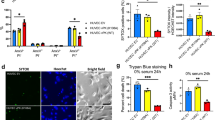Abstract
Kaposi's sarcoma-associated herpesvirus (KSHV), or human herpesvirus 8, has been implicated in the development of Kaposi's sarcoma (KS) and several B-cell lymphoproliferative diseases1,2,3. Most cells in lesions derived from these malignancies are latently infected, and different viral gene products have been identified in association with lytic or latent infection by KSHV4,5. The latency-associated nuclear antigen (LANA), encoded by open reading frame 73 of the KSHV genome, is a highly immunogenic protein that is expressed predominantly during viral latency, in most KS spindle cells and in cell lines established from body-cavity-based lymphomas6,7. Antibodies to LANA can be detected in a high percentage of HIV-infected individuals who subsequently develop KS8,9, although its role in disease pathogenesis is not completely understood. p53 is a potent transcriptional regulator of cell growth whose induction leads either to cell-cycle arrest or apoptosis. Loss of p53 function correlates with cell transformation and oncogenesis10,11, and several viral oncoproteins interact with p53 and modulate its biological activity12,13. Here we show that LANA interacts with the tumour suppressor protein p53 and represses its transcriptional activity. This viral gene product further inhibits the ability of p53 to induce cell death. We propose that LANA contributes to viral persistence and oncogenesis in KS through its ability to promote cell survival by altering p53 function.
This is a preview of subscription content, access via your institution
Access options
Subscribe to this journal
Receive 51 print issues and online access
$199.00 per year
only $3.90 per issue
Buy this article
- Purchase on SpringerLink
- Instant access to full article PDF
Prices may be subject to local taxes which are calculated during checkout





Similar content being viewed by others
References
Chang,Y. et al. Identification of herpesvirus-like DNA sequences in AIDS-associated Kaposi's sarcoma. Science 266, 1865–1869 (1994).
Moore,P. S. & Chang,Y. Detection of herpes-like virus DNA sequences in Kaposi's sarcoma in patients with and without HIV infection. N. Engl. J. Med. 332, 1181–1185 (1995).
Cesarman,E., Chang,Y., Moore,P. S., Said,J. W. & Knowles,D. M. Kaposi's sarcoma-associated herpesvirus-like DNA sequences in AIDS-related body-cavity-based lymphomas. N. Engl. J. Med. 332, 1186–1191 (1995).
Neipel,F., Albrecht,J.-C. & Fleckenstein,B. Cell-homologous genes in the Kaposi's sarcoma-associated rhadinovirus human herpesvirus 8: determinants of its pathogenecity? J. Virol. 71, 4187–4192 (1997).
Sarid,R., Flore,O., Bohenzky,R. A., Chang,Y. & Moore,P. S. Transcription mapping of the Kaposi's sarcoma-associated herpesvirus (human herpesvirus 8) genome in a body. J. Virol. 72, 1005–1012 (1998).
Rainbow,L. et al. The 222- to 234-kilodalton latent nuclear protein (LNA) of Kaposi's sarcoma-associated herpesvirus (human herpesvirus 8) is encoded by orf73 and is a component of the latency-associated nuclear antigen. J. Virol. 71, 5915–5921 (1997).
Kedes,D. H., Lagunoff,M., Renne,R. & Ganem,D. Identification of the gene encoding the major latency-associated nuclear antigen of the Kaposi's sarcoma-associated herpesvirus. J. Clin. Invest. 100, 2606–2610 (1997).
Gao,S. J. et al. Seroconversion to antibodies against Kaposi's sarcoma-associated herpesvirus-related latent nuclear antigens before the development of Kaposi's sarcoma. N. Engl. J. Med. 335, 233–241 (1996).
Kedes,D. H. et al. The seroepidemiology of human herpesvirus 8 (Kaposi's sarcoma-associated herpesvirus): distribution of infection in KS risk groups and evidence for sexual transmission. Nature Med. 2, 918–924 (1996).
Levine,A. J. p53, the cellular gatekeeper for growth and division. Cell 88, 323–331 (1997).
Hollstein,M., Sidransky,D., Vogelstein,B. & Harris,C. C. p53 mutations in human cancers. Science 253, 49–53 (1991).
Ko,L. J. & Prives,C. p53: puzzle and paradigm. Genes Dev. 10, 1054–1072 (1996).
Dobner,T., Horikoshi,N., Rubenwolf,S. & Shenk,T. Blockage by adenovirus E4orf6 of transcriptional activation by the p53 tumor suppressor. Science 272, 1470–1473 (1996).
Werness,B. A., Levine,A. J. & Howley,P. M. Association of human papillomavirus types 16 and 18 E6 proteins with p53. Science 248, 76–79 (1990).
Scheffner,M., Werness,B. A., Huibregtse,J. M., Levine,A. J. & Howley,P. M. The E6 oncoprotein encoded by human papillomavirus types 16 and 18 promotes the degradation of p53. Cell 63, 1129–1136 (1990).
Chen,X., Ko,L. J., Jayaraman,L. & Prives,C. p53 levels, functional domains, and DNA damage determine the extent of the apoptotic response of tumor cells. Genes Dev. 10, 2438–2451 (1996).
Lill,N. L., Grossman,S. R., Ginsberg,D., DeCaprio,J. & Livingston,D. M. Binding and modulation of p53 by p300/CBP coactivators. Nature 387, 823–827 (1997).
Li,R. et al. Mutant p53 protein expression interferes with p53-independent apoptotic pathways. Oncogene 16, 3269–3277 (1998).
Moore,P. S. & Chang,Y. Antiviral activity of tumor-suppressor pathways: clues from molecular piracy by KSHV. Trends Genet. 4, 144–150 (1998).
Chang,Y. et al. Cyclin encoded by KS herpesvirus. Nature 382, 410 (1996).
Ballestas,M. E., Chatis,P. A. & Kaye,K. M. Efficient persistence of extrachromosomal KSHV DNA mediated by latency-associated nuclear antigen. Science 284, 641–644 (1999).
Li,J. J. et al. Expression and mutation of the tumor suppressor gene p53 in AIDS-associated Kaposi's sarcoma. Am. J. Dermatopathol. 19, 373–378 (1979).
Noel,J.-C. p53 protein and Kaposi's sarcoma. Am. J. Dermatopathol. 19, 322–322 (1997).
Kern,S. A. et al. Oncogenic forms of p53 inhibit p53-regulated gene expression. Science 256, 827–830 (1992).
Hottiger,M. O. & Nabel,G. J. Interaction of human immunodeficiency virus type 1 Tat with the transcriptional coactivators p300 and CREB binding protein. J. Virol. 72, 8252–8256 (1998).
Felzien,L. K. et al. HIV transcriptional activation by the accessory protein, VPR, is mediated by the p300 co-activator. Proc. Natl Acad. Sci. USA 95, 5281–5286 (1998).
Emami,K. H. & Carey,M. A synergistic increase in potency of a multimerized VP16 transcriptional activation domain. EMBO J. 11, 5005–5012 (1992).
Yang,S. et al. Generation of retroviral vector for clinical studies using transient transfection. Hum. Gene Ther. 10, 123–132 (1990).
Chen,C. & Okayama,H. High-efficiency transformation of mammalian cells by plasmid DNA. Mol. Cell. Biol. 7, 2745–2752 (1987).
Leung,K. & Nabel,G. J. HTLV-1 transactivator induces interleukin-2 receptor expression through an NF-kB-like factor. Nature 333, 776–778 (1988).
Acknowledgements
We thank D. Gschwend and N. Barrett for manuscript preparation, E. S. Robertson and R. Mosavin for helpful discussions, B. Chandran for providing a polyclonal antibody to LANA and members of the Nabel Lab for helpful comments. J.F. is supported by a fellowship from the Medical Research Council of Canada. M.O.H. is supported by the Kanton of Zurich. This work was supported in part by the Howard Hughes Medical Institute.
Author information
Authors and Affiliations
Corresponding author
Rights and permissions
About this article
Cite this article
Friborg, J., Kong, Wp., Hottiger, M. et al. p53 inhibition by the LANA protein of KSHV protects against cell death. Nature 402, 889–894 (1999). https://doi.org/10.1038/47266
Received:
Accepted:
Issue Date:
DOI: https://doi.org/10.1038/47266



